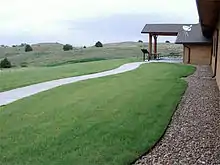Bouteloua dactyloides
Bouteloua dactyloides, commonly known as buffalograss or buffalo grass, is a North American prairie grass native to Canada, Mexico, and the United States. It is a shortgrass found mainly on the High Plains and is co-dominant with blue grama (B. gracilis) over most of the shortgrass prairie.[3]
| Bouteloua dactyloides | |
|---|---|
 | |
| Turf-type buffalograss | |
| Scientific classification | |
| Kingdom: | Plantae |
| Clade: | Tracheophytes |
| Clade: | Angiosperms |
| Clade: | Monocots |
| Clade: | Commelinids |
| Order: | Poales |
| Family: | Poaceae |
| Genus: | Bouteloua |
| Species: | B. dactyloides |
| Binomial name | |
| Bouteloua dactyloides (Nutt.) Columbus 1999 | |
| Synonyms[1][2] | |
|
List
| |
Buffalo grass in North America is not the same species of grass commonly known as "buffalo" in Australia. It should not be confused with Stenotaphrum secundatum varieties such as 'Sir Walter' or 'Palmetto'.
Description
Buffalograss is a warm-season perennial shortgrass. It is drought-, heat-, and cold-resistant. Foliage is usually 5–13 cm (2.0–5.1 in) high, though in the southern Great Plains, foliage may reach 30 cm (12 in). Buffalograss is usually dioecious, but sometimes monoecious or with perfect flowers. Flower stalks are 10–20 cm (3.9–7.9 in) tall. The male inflorescence is a panicle; the female inflorescence consists of short spikelets borne in burlike clusters, usually with two to four spikelets per bur.
Buffalograss sends out numerous, branching stolons; occasionally, it also produces rhizomes. Roots are also numerous and thoroughly occupy the soil. The numerous stolons and roots form a dense sod. Buffalograss roots are finer than those of most plains grasses, being less than 1 mm (0.039 in) in diameter.[3]
Range
Buffalograss is common and widespread across most of the Great Plains and in scattered locations in neighboring regions, from the Canadian Prairie Provinces to central Mexico, as well as the Mississippi Valley and the Intermountain Region.[3][4]
In Australia B. dactyloides is not called buffalograss, but is referred to as 'prairie grass'.
Taxonomy
Bouteloua dactyloides was initially placed by Thomas Nuttall in the genus Sesleria.[1] It was later moved to the monotypic genus Buchloe.[5] In 1999, James Travis Columbus moved buffalograss to Bouteloua, which also contains the grama grasses.[1]
Uses
Lawn and garden
Buffalograss is used as a drought-tolerant turfgrass in North America and is also grown for forage. Turfgrass cultivars include '609', 'Prairie', 'Stampede', and 'Density', while 'Comanche' and 'Texoka' are intended for forage.[6] In addition, researchers at the University of California Riverside and University of California Davis have hybridized a buffalograss cultivar, 'UC Verde',[7] creating a thick, green, drought-tolerant lawn for California's hot, dry summers. Agricultural scientist at University of Nebraska developed Legacy as a turf grass variety.[8] Buffalo grass can be established from seeded cultivars, such as Cody, Bowie and Sundancer, or from vegetative cultivars like Legacy and Prestige.[9]
Building
Settlers used its dense sod to build sod houses.[10]
Diseases
Buffalograss false smut is a fungal disease caused by Porocercospora seminalis (formerly placed in the genus Cercospora). Infection by the fungus prevents normal caryopsis development, resulting in loss of yield and reduced seed germination.[11]
References
- "Bouteloua dactyloides". Germplasm Resources Information Network (GRIN). Agricultural Research Service (ARS), United States Department of Agriculture (USDA). Retrieved 2010-03-05.
- "Buchloe dactyloides". World Checklist of Selected Plant Families (WCSP). Royal Botanic Gardens, Kew – via The Plant List.
- Howard, Janet L. (1995). "Buchloe dactyloides". Fire Effects Information System (FEIS). US Department of Agriculture (USDA), Forest Service (USFS), Rocky Mountain Research Station, Fire Sciences Laboratory. Retrieved 2010-07-31 – via https://www.feis-crs.org/feis/.
- https://www.gov.mb.ca/conservation/wildlife/sar/pdf/buffalograss.pdf
- Quattrocchi, Umberto (2006). CRC World Dictionary of Grasses. II E-O. CRC Press. p. 395. ISBN 978-0-8493-1303-5.
- "Buchloe dactyloides". Native Plant Database. Lady Bird Johnson Wildflower Center, University of Texas at Austin. Retrieved 2010-07-31.
- "UC Verde Buffalograss". University of California, Davis. Archived from the original on 2016-03-19. Retrieved 2016-04-24.
- "Legacy Buffalo Grass Plugs". High Country Gardens. Retrieved December 23, 2020.
- Browning, Sarah. "Selection and establishment guidelines for buffalo grass success". Lincoln Journal Star. Retrieved December 23, 2020.
- Riordan, T.P.; S.J. Browning (2003). "Buffalograss, Buchloe dactyloides (Nutt.) Engelm". In Michael D. Casler; Ronny R. Duncan (eds.). Turfgrass Biology, Genetics, and Breeding. John Wiley and Sons. p. 257. ISBN 978-0-471-44410-7.
- Amaradasa BS, Madrid H, Groenewald JZ, Crous PW, Amundsen K (2014). "Porocercospora seminalis gen. et comb. nov., the causal organism of buffalograss false smut". Mycologia. 106 (1): 77–85. doi:10.3852/13-147. PMID 24603834. S2CID 6971566.
Further reading
- McConnell, Primrose (1911), , in Chisholm, Hugh (ed.), Encyclopædia Britannica, 12 (11th ed.), Cambridge University Press, pp. 367–369.
- Chisholm, Hugh, ed. (1911), , Encyclopædia Britannica, 12 (11th ed.), Cambridge University Press, pp. 369–377.
External links
| Wikimedia Commons has media related to Bouteloua dactyloides. |
| Wikispecies has information related to Bouteloua dactyloides. |
- Turf-Type Buchloe dactyloides at Native Turf Group (nonprofit)
- photo of herbarium specimen at Missouri Botanical Garden collected in Texas in 1846